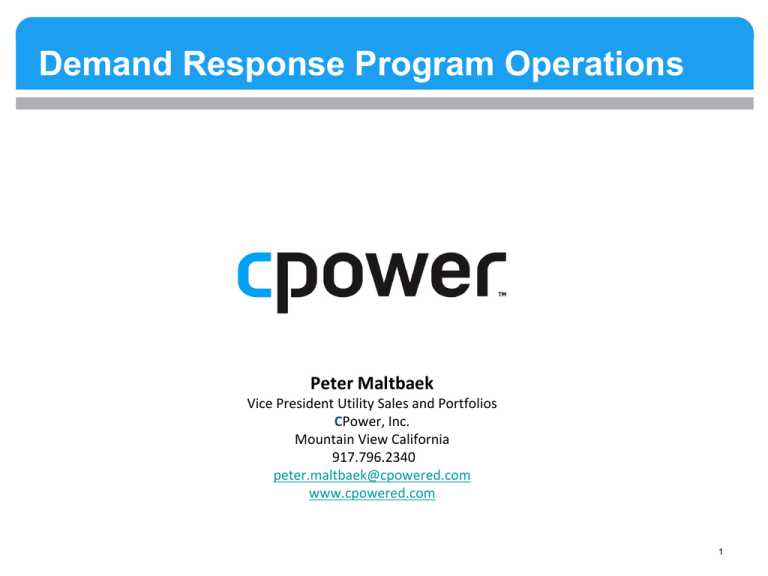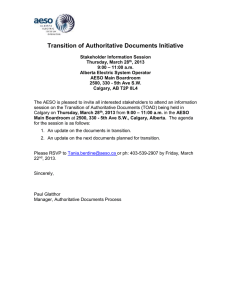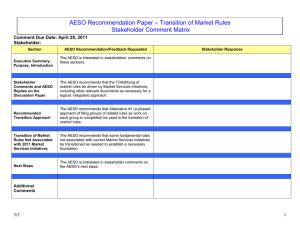Demand Response Program Operations Peter Maltbaek Vice President Utility Sales and Portfolios
advertisement

Demand Response Program Operations Peter Maltbaek Vice President Utility Sales and Portfolios CPower, Inc. Mountain View California 917.796.2340 peter.maltbaek@cpowered.com www.cpowered.com 1 Agenda • Introduction to CPower • Basic design issues • DR in various markets • Ancillary Services • Capacity • Energy • Alternatives for AESO 2 About CPower Founded in 2001, privately owned One of the largest and most experienced non-utility demand response providers in North America • >1,800 MW of electric load under management • 75 million square feet of commercial, industrial, and institutional properties • Over 120,000 residential units Active participant in Ontario, California, New York, New England, MidAtlantic, and Texas and Ontario energy markets Parent company of Xtend Energy and Ancillary Services Coalition (ASC) California, pioneering providers of Demand Response to ancillary services markets in Texas and California, respectively Headquarters in Manhattan, NY Regional offices in Toronto; Brea, CA; North Adams, MA; Austin, TX; Oxford, CT; Lawrence, MA; and Allentown, PA 3 Basics - Markets or Programs? Historically, there have been two approaches to DR. •In the market-based approach, the ISO creates performance specifications that make DR look like existing products. DR is then competitively bid into existing markets. •In the program approach, utilities and regulators design demand response programs. Utilities then implement programs or issue RFPs, typically with costs recovered from ratepayers. •Programs must meet cost-effectiveness tests 4 Market-Based Approach: Pros and Cons The market based approach to demand response shares many of the advantages and disadvantages of deregulation: •Easier to ensure cost-effectiveness: DR is only procured if it is able to clear in competition with traditional generation •No need to administratively decide how much DR to procure: the markets decide the ‘right’ level of DR •So long as DR performance requirements match system needs, gives participants greater flexibility to decide what resources they enroll and how they’ll implement demand response •Increases risk to program participants •Barriers to entry can slow initial DR growth •There can be problems capturing and rewarding true value of DR 5 Program-Based Approach: Pros and Cons The program based approach to demand response has similar issues with efforts to promote energy efficiency: •Helps overcome entry barriers, making this approach good at creating new DR in the early stages •Can be integrated with other policy goals •Gives regulators and utilities more control over how much DR to provide and how to provide it •More risk falls on ratepayers •Can be economically inefficient, as DR is not forced to compete on a like-vs-like (directly comparable) basis with generation •There can be complex interactions between multiple Utility and Aggregator programs 6 Markets vs. Programs: CPower’s View Overall, we believe that as Demand Response becomes a more mainstream product, most ISOs are moving towards the market-based approach •Much easier to have competition in a market, creating a more robust supply of DR •Price signals have proven effective at stimulating DR where it is most needed. •Regulators don’t have to try and pick the winning approach or determine exactly how much DR is the right amount. •Portfolio standards or incentive payments allow regulators to influence the amount of DR to support policy goals •Matching DR with existing products makes it easier to integrate into grid operations 7 Basics 2: Utility Run or Competitive Providers? Much like provision of retail power, access to end-users can either be limited to their incumbent utility or opened to third-party providers. •In the utility approach, end-users’ DR capacity is considered part of the utility’s franchise. Historically, most end-users enrolled in DR through some sort of interruptible tariff. •In the competitive approach, end-users are free to enroll through their choice of Curtailment Service Provider (CSP). CSPs purchase DR capacity from retail customers and sell into wholesale markets or programs. 8 Utility Approach: Pros and Cons The utility based approach limits end-user participation to offerings made by their utility. •Better able to meet utility-specific needs such as suppoting the distribution system or hedging against wholesale prices. •Reduces regulatory concerns, especially in areas without retail choice. •Allows utilities to better integrate DR into their resource planning and energy purchases. •Eliminates concerns that DR amounts to improper resale of electricity •May be easier to understand for customers. •Utilities may see a conflict of interest between selling electricity and encouraging demand response. 9 Competitive Approach: Pros and Cons The competitive approach to demand response presents similar issues to retail choice: •Competition gives end-users more choice, hopefully providing them with better prices, improved customer service, and more participation options. •As DR is their primary line of business, CSPs are highly motivated to enroll end-users. •Might make it more difficult to integrate DR into resource adequacy planning. •Difficult for the ISO to avoid getting involved in retail issues. •Care must be taken to ensure that costs of DR are not inappropriately socialized. 10 Utility vs. Competitive, CPower’s View As an independent demand response provider, we prefer an open, competitive market. We believe that this approach is much more likely to deliver meaningful amounts of demand response: •Historically, enrollment in interruptible rate tariffs has been limited •Markets with CSP participation generally see higher levels of demand response •Competitive markets give end-users greater price transparency •Cost allocation issues can be solved by proper settlement procedures •Since AESO covers a single province, regulatory issues are manageable •Utilities free to design their own programs to meet particular needs 11 Current DR Approach by ISO OPA: ISO-run capacity market program CAISO: Utility capacity programs only, in process of switching to a direct ISO market (price-responsive) MISO: Energy market open to utilities and large loads, developing rules for smaller load participation and ancillary services. PJM, ISONE. NYISO, ERCOT: Competitive wholesale market for all products 12 Demand Response in Power Markets Currently, various ISOs allow demand response to participate in nearly all power markets: •Energy: Demand response bids kWh reductions into day-ahead, real-time, or self-scheduled energy markets. •Capacity: Demand resources make forward commitments to curtail when called upon, allowing DR to serve in resource adequacy planning. •Ancillary Services: Demand resources provide reserve or regulation services with roughly the same characteristics as generation. 13 Demand Response Markets by ISO Energy OPA Capacity A/S Program CAISO Upcoming Utility Programs Upcoming MISO Yes Partial Upcoming PJM Yes Yes Yes ISO-NE Yes Yes Yes NYISO Yes Yes ERCOT Yes Yes 14 Energy Markets Most ISOs have provisions for demand response to sell curtailments as energy. •In general, energy provided is measured as curtailment from a calculated baseline •Bid into day-ahead and real-time markets just like generation •Some ISOs allow DR to self-schedule curtailments and be compensated based on the prevailing LMP •Generally only attractive to load in very high energy price situations, or if capacity value recognized 15 Energy Market Design Issues Energy markets have proven to be the most challenging to design correctly. •Correctly calculating baselines is critical. Early programs had gaming issues caused by improper baseline design. •Settlement should recognize that economic curtailment imposes costs on EDCs, possibly including lost revenue and balancing charges. These may be addressed either through make-whole payments from the CSPs to the EDC, or through socialized charges. •Revenues are generally low, limiting participation. •But, AESO has ‘spiky’ LMPs that frequently hit very high prices. This may make the AESO energy market more attractive to DR than other ISO’s. 16 Energy Market Potential in AESO Various features of AESO make a demand response energy market attractive: •Frequent, short periods of high LMP encourage participation •System benefits of economic and emergency DR are especially important in a relatively small, isolated system with “radial” characteristics and lack of cheap fast-response resources Alberta 2008 (Jan to Sep) 12000 1000 900 800 700 [MWh] 600 6000 500 400 [$/MWh] 2008 Alberta Load 2008 Alberta Spot Price 9000 300 3000 200 100 0 100% 0 90% 80% 70% 60% 50% 40% 30% 20% 10% 17 Capacity Markets In many ways, demand response resembles a ‘super peaker,’ with very low capital costs, short build times, and high operating costs. This makes them a natural fit for capacity markets. •Resources make forward commitments to curtail when called upon, generally as a stage in the emergency procedures process. •Most capacity markets operate through periodic auctions, with EDCs required to purchase sufficient capacity to meet resource adequacy reserve requirements. •Given that AESO does not currently have a capacity market, this option is probably best deployed at the utility/muni level in Alberta •Can used by utilities to supplement ISO market offerings 18 Capacity Market Design Issues •How frequently can resources be called? For how long? Existing programs vary from X to Y events per year, of X-Y hour duration. •Should there be a limit on the amount of DR procured? Limits on how often it can be called need to be considered. •E.g. if DR amounts to 3% of your capacity, need to make sure that the number of ‘peak 3% hours’ doesn’t exceed the number of hours you can call upon the DR. •ISO-NE is the leader in this, with DR approaching 10% of their installed capacity. •What are the testing and performance requirements? What penalties are imposed? Are these sufficient to prevent gaming? •Capacity programs can be tailored to meet specific locational issues such as easing strain on distribution networks or transmission congestion. 19 Ancillary Services: Synch Reserve Synch Reserve (or similar 10 to 30 minute products) •Reliability organizations are increasingly allowing demand response to meet a portion of system ready reserve requirements. •Demand response has been very successful at providing these products. Notably, DR was credited with preventing widespread load drops in ERCOT during an unexpected wind drop-off last summer. DR is now the leading provider of synch reserve in PJM’s market. •Like capacity, these markets are a good match for DR’s low capital/high operating cost structure. •With appropriate controls, many types of end-user can ramp down load in 10 minutes or less •Short curtailment times minimize costs of curtailment •A reserves product may be the ideal solution for AESO’s ramp rate issues. 20 Reserve Products in AESO From earlier presentations, demand response reserves are good fit to several AESO needs: •Presentations in September DRWG meeting highlighted need for increased ramp rate to handle large coal units going off line. The cost structure of DR makes it an economical solution to increase system ramp-up rates. •DR particularly good (fast) at handling wind drop as wind becomes significant part of generation •Longer lead-time DR (say, 1 to 4 hour notification, or day-ahead) can be deployed to dampen price swings caused by expected outages of large units. 21 Ancillary Services: Regulation Demand Response has had more difficulty providing frequency regulation products. •Very technically demanding. Few loads can ramp up and down with the precision and speed these products require (but there are examples – pumps, air conditioners, pevs?) •Load is generally better at providing reg-up (=reduced load) than regdown. DR has been most successful in markets that have separate up and down regulation products. •Most participation is by large, sophisticated industrials—aluminum smelters, chemical plants, water pumpers etc. •Some kinds of load common in Alberta, such as pumping stations and extractive industries, have proven able to provide regulation. 22 Ancillary Services: Other Products The Wind Impact Study from 2006 concluded that AESO may need more ramp-down capacity to fully integrate large amounts of wind. •Is this still a concern? If so, may be a niche for demand response. •Generally, DR is not a good provider of ramp-down, as it’s easier for customers to reduce load than increase it. •But, Alberta is unique in that many end-users meet routinely meet portions of their load using their own generation. •Is a ‘reverse-DR’ product possible? In this case, Demand Response would mean ordering end-users to turn off their generation. 23 Roles for Demand Response Ways Demand Resources could help • Provide supplemental reserves • Demand Response is an economical source of 10-minute reserves • Perfect fit to ramp rate issues • Procuring more supplemental reserves could allow regulating reserve resources to be biased towards the top of their range, creating more ramp-down capacity • Fits into existing AESO product mix • Enter the energy market • High, variable energy prices demonstrate the value of this product • Efficient way to integrate backup generation into grid operations • Fits into existing AESO product mix 24 A Straw Proposal For discussion purposes, CPower suggests the following for AESO: • Go with a market-based approach, • But be sure full value of DR recognized and compensated • Allow CSPs to aggregate retail customers into resources that can be bid into AESO markets • Synch reserve is the low-hanging fruit; make allowing DR entry into that market the first goal • At the same time, begin discussions on regulatory, M&V, and settlement issues related to DR participation in energy markets 25


